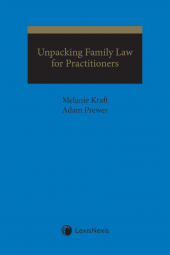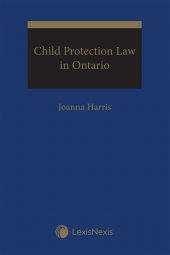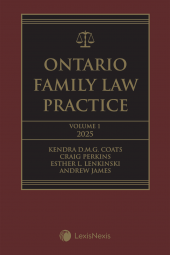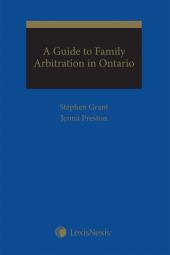Unpacking Family Law for Practitioners
One Year Subscription Only Terms
Subscribers receive the product(s) listed on the Order Form and any Updates made available during the annual subscription period. Shipping and handling fees are not included in the annual price.
Subscribers are advised of the number of Updates that were made to the particular publication the prior year. The number of Updates may vary due to developments in the law and other publishing issues, but subscribers may use this as a rough estimate of future shipments. Subscribers may call Customer Support at 800-833-9844 for additional information.
Subscribers may cancel this subscription by: calling Customer Support at 800-833-9844; emailing customer.support@lexisnexis.com; or returning the invoice marked 'CANCEL'.
If subscribers cancel within 30 days after the product is ordered or received and return the product at their expense, then they will receive a full credit of the price for the annual subscription.
If subscribers cancel between 31 and 60 days after the invoice date and return the product at their expense, then they will receive a 5/6th credit of the price for the annual subscription. No credit will be given for cancellations more than 60 days after the invoice date. To receive any credit, subscriber must return all product(s) shipped during the year at their expense within the applicable cancellation period listed above.
Détails des produits
As societal notions of what constitutes a “family” evolve, so does the law that aims to govern the creation and dissolution of familial relationships. This volume aims to address that evolution, and the family law issues that arise as a result, in an accessible, easy-to-understand format.
A Go-To Resource
Written by two family law experts with many decades of combined experience – Madam Justice Melanie Kraft of the Ontario Superior Court of Justice and Adam Prewer, partner at family law firm Epstein Cole LLP – Unpacking Family Law for Practitioners provides valuable insight into the theory and practice of family law today.
This useful volume offers real-world guidance on navigating the ins and outs of family law in Ontario and would be a particularly helpful resource for law students, the self-represented, junior lawyers, mediators and arbitrators, and practitioners who are new to this practice area.
In addition to addressing the fundamentals of family law – from decision making authority and parenting schedules, to child and spousal support, to division of property – it covers the basics of court procedure and includes key cases, relevant statutes, recent developments in the law and helpful practice tips.
Chock-full of information and practical direction, Unpacking Family Law for Practitioners is a must-have book for anyone seeking to gain a better understanding of family law in Ontario.
Table des matières
Chapter 1: The changing definition of “family”
The definition of “family”
Trends in family law
Constitutional issues in family law
Legal remedies available
Regulating marriage
Chapter 2: Violence in the family
Legal responses to family violence
Decision-making and parenting issues in the face of family violence
Child protection
Tort law
Chapter 3: Court structure and family law procedure
Court structure
Family law procedure
The process of starting a family law case
Alternatives to going to court
Additional resources available in family court
Chapter 4: Property rights
Historical context
Legal reform in the area of property division
Equalization: Sharing the economic gain of marriage
Rights of common-law spouses to property division
Chapter 5: Decision-making responsibility and parenting time
Recent amendments to the Divorce Act
Parenting orders
Views and preferences of the child
Custody and access assessments
Parenting plans
High conflict separations – Parental alienation
Alternatives to litigating parenting issues
Chapter 6: Child support
Basic principles of child support
The Child Support Guidelines and how to use them
What constitutes a Section 7 expense?
How to calculate income of a payor
Incomes over $150,000
How to conduct annual disclosure and review
What happens if there is shared or split custody?
What if the payor has children from another marriage?
What happens if there are two payors?
Child support for an adult child
Child support where the child and the payor are estranged
Undue hardship
Contracting out of the Guidelines
Retroactive child support
Chapter 7: Spousal support
Legislative provisions
Principles of spousal support
Entitlement to spousal support
Quantum and duration of spousal support
The Spousal Support Advisory Guidelines and how to use them
Retroactive spousal support
Chapter 8: Domestic contracts
A brief history of contracts in family law
Types of domestic contracts
Formal requirements of domestic contracts
Setting aside domestic contracts
Effect of enforceable and valid contracts
Chapter 9: The matrimonial home
Part II of the Family Law Act
Order for exclusive possession
Partition and sale of the matrimonial home
Possessory rights in the matrimonial home
Occupation rights of common-law spouses
Chapter 10: Reproductive technology
All Families Are Equal Act, Bill 28
Presumptions concerning parentage
Surrogacy and gamete donation
Assisted Human Reproduction Act
Chapter 11: Motions to change
Motion to change procedure
The legal test on a motion to change
Chapter 12: How to settle a family law case
Direct negotiations
Mediation
Arbitration
Going to court
 Lexis Nexis
Lexis Nexis 


